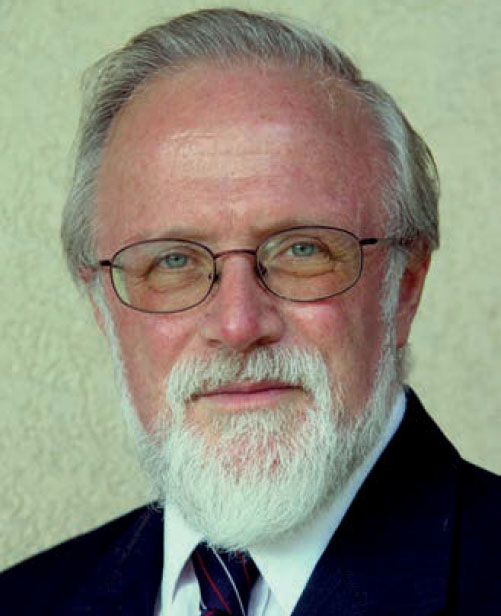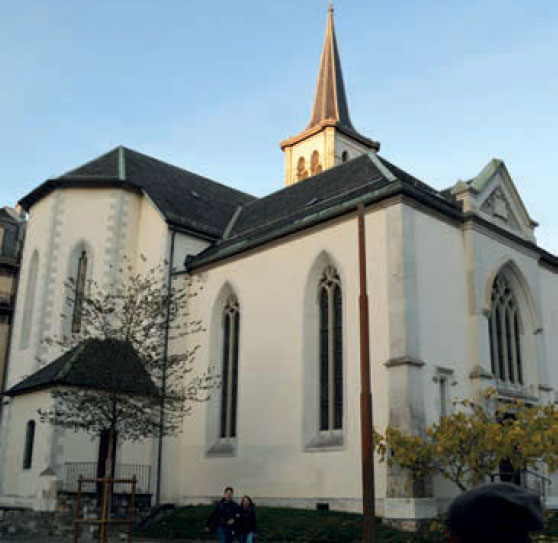Jackie Macadam meets the Church of Scotland member behind a Europe-wide celebration of the Reformation.
AS the countdown begins towards the 500th anniversary of the Reformation, one member of the Church of Scotland congregation in Geneva is playing a key role in a major part of the celebrations.
Arthur Askew, came to Geneva to work with the World Meteorological Organisation (WMO) in 1970 and then spent seven years in Australia before returning to Geneva in 1977 where he’s lived ever since.
“Geneva’s own history, and hence its very identity, is very much bound up with the Reformation,” he explained.
“The Reformation, and historical references to it are used in many contexts on a daily basis.
“Above all, the Reformation is an ever-present fact for us in the Church of Scotland here.
“The building in which we worship is a place of pilgrimage for those of the Presbyterian tradition and for protestants in general. We have the great privilege to be able to use the Auditoire de Calvin, a small and beautiful 12th century church right next to the Cathedral, in the heart of the old town. The building is the property of the ‘Eglise Protestante de Geneve’ – the Protestant Church of Geneva.”
Arthur was born in Bristol, read civil engineering at Birmingham University and then went overseas for his postgraduate studies, being awarded a PhD in water engineering in Sydney.
Two years in Los Angeles followed, carrying out research into the optimum use of scarce water resources, before coming to Geneva for two years with the WMO, a technical agency of the United Nations.
“For most of my life I've worked for meteorologists, but I’m not one myself!
“Studying water resources requires that we first understand the availability, variability and the quality of the fresh water that we have. This is the discipline of hydrology and so, from being a civil engineer, I became a hydrologist. Hydrology is a geoscience, so I’m now more of a scientist.
“I get annoyed when people try to create a disagreement between faith and science. In my experience, scientists and people of faith can have a very close relationship.
“Last year in fact, under the leadership of our then minister, the Rev Ian Manson, our congregation participated in a project entitled Scientists in Congregations, Scotland, launched out of the University of St Andrews with support from the John Templeton Foundation.
“We involved clergy from local Englishspeaking churches together with scientists from CERN – where the Higgs boson particle was discovered – from the World Health Organisation and other international bodies.
“We had four evenings of fascinating discussions that led to a clear agreement that scientific investigation and religious faith are completely compatible with each other. Contrary to the almost hysterical claims of some of the more aggressive atheists, many scientists find it is their faith in a personal God who is also the Creator of the world that gives them a firm foundation for seeking to understand the world He created.”
And Arthur finds that his faith has given even more importance to his work as a scientist.
“The link between faith and science has given me a real satisfaction with the work I do. I have worked at an international level to improve our understanding of the world’s water resources that are so vital to life on this planet – vital not only for the survival of human beings – but also for all other living things.
“I have felt blessed that I can live in such a fascinating city, working on such an important subject, in co-operation with some very dedicated staff.”
‘Blessed’ is a word Arthur also uses to describe his personal life as well.
“I was raised in a very Christian home. My father was a lay preacher in the Baptist church and all my friends and spare time were linked with the church.
“In my teens I realised my need for personal salvation and so I was baptised as an adult.
“When I moved to Geneva, I met with a somewhat cool reception at a couple of churches and then found a home in the Church of Scotland here. I enjoyed the community and joined the choir of the church.
“That’s where I met my wife, Janet, and we were married 18 months later.
“We have been blessed with two sons. One was born in Australia, and now lives in England and the other was born here in Geneva and currently lives in Seattle, USA.
“That means Janet and I are in a fairly common position for members of the international community here; our family is spread around the world. If we are blessed with grandchildren, it will be a long round trip to do the baby-sitting!
“When I met Janet, we found that we had many things in common, especially the very warm and personal welcome we received at the Church of Scotland, led at the time by the Rev Peter Logan-Ayre.
“The Church of Scotland means so much to Janet and me. We have both been involved in its life ever since we arrived in the city. Indeed, Janet is an elder and for many years, I was secretary of the Congregational Committee/Board.
“As I mentioned earlier, we have the privilege of using the Auditoire de Calvin as our place of worship. After Geneva chose to accept the teaching of the reformers, the Cathedral was no longer needed for the elaborate ceremonies of the Catholic tradition. It was used simply for worship but that left the Auditoire largely unused until in 1555, Calvin arranged for it to be put at the disposal of the British refugees fleeing from the persecution of England’s Queen Mary, also known as ‘Bloody Mary’ and daughter of Henry VIII.

Arthur Askew
The Church of Scotland means so much to Janet and me. We have both been involved in its life ever since we arrived in the city. Indeed, Janet is an elder and for many years, I was secretary of the Congregational Committee/Board.
“One of these refugees was John Knox, who served as Pastor of this community from 1556 until 1559.
“Undoubtedly, Knox and Calvin would have had long discussions on theological matters and the governance of the church. I’d love to be able to go back in time and be a fly on the wall when they were talking – in French I assume.
“It was from here in fact, that Knox took so much back to Scotland and launched the reformation there.
“Our church building is absolutely steeped in the Reformation and we who worship there are constantly reminded of its historical importance and its importance for our lives today. Many of the members here spend quite a lot of time talking to visitors about the history of the church.
“Of course, when we approach the Reformation, you understand there is a bit of gentle disagreement among the various churches here about what that actually means.
“Our Lutheran friends quote the date October 31 1517 as if the Reformation actually started on that day. There can be no doubt that it was probably the most significant single event in the history of the Protestant Church but then what of Jan Huus (1369-1415), John Wycliffe (1320-1384) and Pierre Waldo (1140-1205)? This last name may not be familiar to many of your readers, but he is important to us here, because we share the use of the Auditoire de Calvin with the Waldensian Church in Geneva. This friendly group of devoted Italians are the inheritors of the teachings of Pierre Waldo who lived more than 800 years ago. Ecclesia semper reformanda est to quote the famous phrase used by Karl Barth.

World Reformation Exhibition Truck
“Understandably, our Lutheran colleagues are keen to commemorate this event, not just in Wittenberg but throughout Europe and, not just on one day, but throughout the whole year leading up to November 2017.
“Faced with the challenge of tying events together over 365 days and throughout the continent they came up with the novel idea of sending a truck – actually a large blue articulated truck – to travel to 67 cities in 19 countries in order to forge a link between the various celebrations. This is the so-called European Road Map.
“Geneva was chosen as the starting point for the big blue vehicle because of its strong links to the Reformation, more to do with Calvin than Luther of course, its reputation as an international centre for refuge and peace and because it is the home, not only of the World Council of Churches, but also and more specifically of the World Lutheran Federation. So on November 3 and 4 the truck was parked in the centre of the city and in marquees next to it were held debates on theological issues and activities to attract children. The World Council of Churches and the Federation of Swiss Protestant Churches (FEPS) set up stands to make contact with those who visited. Later on, and in particular close to the actual anniversary in 2017, we expect the EPG to join with the 23 other protestant churches in Switzerland to focus again on the importance of Luther’s singular action. The emphasis here is to use the anniversary, not so much as a time for historical reflection, but as a spring board to renewed action.
“On November 3, I arranged for our minister to play a role in the service that was held to mark the launch of the big blue truck and thus make the link to John Knox a reality and not just a historical fact. At the close of the service, the very pleasant young Germans who are accompanying the truck were blessed by pastors, first in French and then in their own language, German, before beginning their mission.
“Lots of events are planned throughout Europe.

Auditoire de Calvin, Geneva
Our church building is absolutely steeped in the Reformation and we who worship there are constantly reminded of its historical importance and its importance for our lives today. Many of the members here spend quite a lot of time talking to visitors about the history of the church.
“In May 2017 the route will wend its way to Central Germany and end up in Wittenberg at the World Reformation Exhibition. Cities in the Netherlands and Hungary will be way-stations, as will Rome, Augsburg, Worms and Wartburg.
On enquiring with the organisers, we were told that, for various good reasons, the truck will not be coming north of the border. However, Church of Scotland congregations south of the border may well be involved in its visits to cities in England.
Each stop-over will last 36 hours: regional and ecumenical partners will invite people to a festive occasion with numerous activities, in order to discover traces of Reformation history in the local area.
A fresh staging of events will bring the past to life. Personal narratives will testify to present-day Reformation viewpoints. Each way-station will pass on a memory to the World Reformation Exhibition in Lutherstadt Wittenberg.
“The Truck will travel to Dublin, then cross to the UK and visit Liverpool, Cambridge and London, before heading to Northern Europe and visiting Denmark, Norway, Sweden and Finland.
“From Finland it heads to Eastern Europe to Latvia before heading back to Germany for a service and act of celebration in Wittenberg.
“The Reformation is about a new beginning – and that doesn’t stop now,” says Arthur. “At each way-station, the celebrations will give the churches and their members a chance to look again of the principals that were at the heart of the Reformation and be inspired to renew their committement to serve the Lord.”
Interested in the European celebrations?
You can download the 2017 ‘Reformation Summer 2017 brochure at
https://r2017.org/fileadmin/downloads/r2017_broschuere_reformationssommer_englisch.pdf
and the European Roadmap at
https://r2017.org/en/european-roadmap/